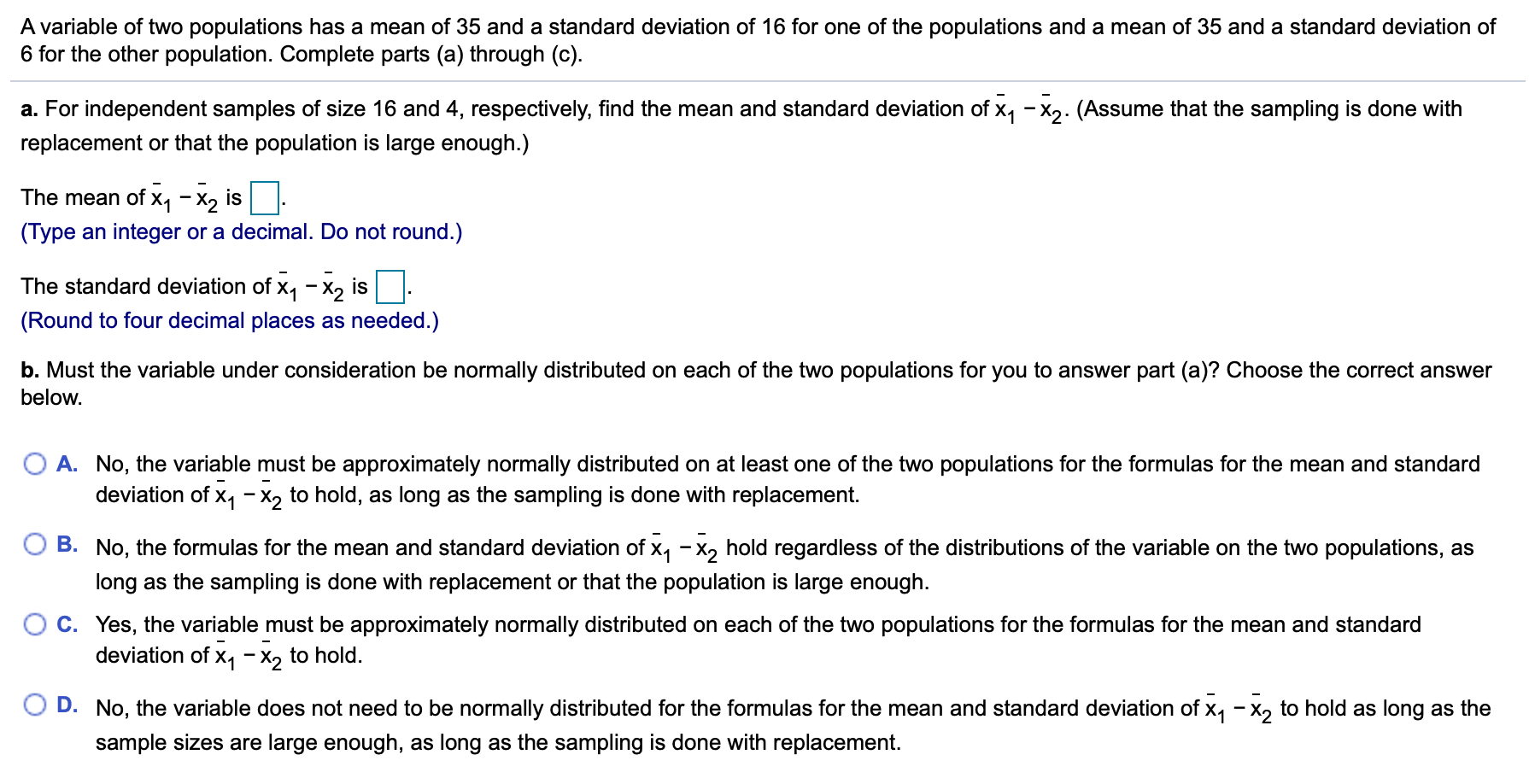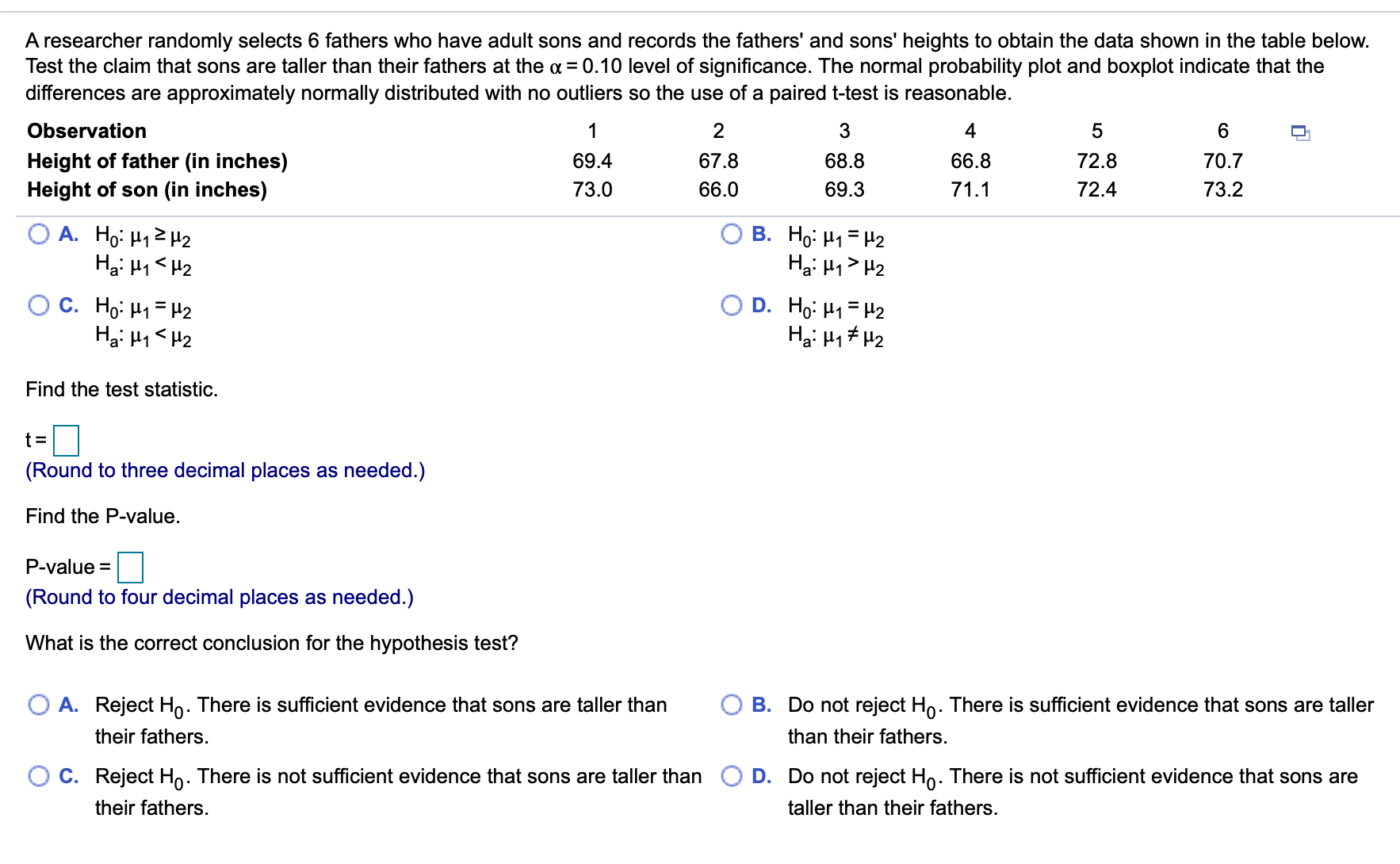i dont understand how to do these questions. this is just homework and homework for this class is not graded only the tests. im just trying to learn how to do it before the test
Avariable of two populations has a mean of 35 and a standard deviation of 16 for one of the populations and a mean of 35 and a standard deviation of 6 for the other population. Complete parts (a) through (c). a. For independent samples of size 16 and 4, respectively, find the mean and standard deviation of i1 - i2. (Assume that the sampling is done with replacement or that the population is large enough.) The mean of i1 )_(2 is D. (Type an integer or a decimal. Do not round.) The standard deviation of i1 - i2 is D. (Round to four decimal places as needed.) b. Must the variable under consideration be normally distributed on each of the two populations for you to answer part (a)? Choose the correct answer below. 0 A. No, the variable must be approximately normally distributed on at least one of the two populations for the formulas for the mean and standard deviation of x1 -x2 to hold, as long as the sampling is done with replacement. 0 B- No, the formulas for the mean and standard deviation of i1 :12 hold regardless of the distributions of the variable on the two populations, as long as the sampling is done with replacement or that the population is large enough. 0 c. Yes, the variable _rnust be approximately normally distributed on each of the two populations for the formulas for the mean and standard deviation of x.I - x2 to hold. 0 D- No, the variable does not need to be normally distributed for the formulas for the mean and standard deviation of i1 -)_(2 to hold as long as the sample sizes are large enough, as long as the sampling is done with replacement. A variable of two populations has a mean of 35 and a standard deviation of 16 for one of the populations and a mean of 35 and a standard deviation of 6 for the other population. Complete parts (a) through (c). b. Must the variable under consideration be normally distributed on each of the two populations for you to answer part (a)? Choose the correct answer below. O A. No, the variable must be approximately normally distributed on at least one of the two populations for the formulas for the mean and standard deviation of X1 - X2 to hold, as long as the sampling is done with replacement. O B. No, the formulas for the mean and standard deviation of x, - X2 hold regardless of the distributions of the variable on the two populations, as long as the sampling is done with replacement or that the population is large enough. O C. Yes, the variable must be approximately normally distributed on each of the two populations for the formulas for the mean and standard deviation of X1 - X2 to hold. O D. No, the variable does not need to be normally distributed for the formulas for the mean and standard deviation of X, - X2 to hold as long as the sample sizes are large enough, as long as the sampling is done with replacement. c. Can you conclude that the variable x1 - X2 is normally distributed? Explain your answer. Choose the correct answer below. O A. No, X1 - X2 is normally distributed only if x is normally distributed on each of the two populations or if the sample sizes are large enough. O B. Yes, X1 - X2 is always normally distributed because it is calculated using parameters. O C. No, since x1 - X2 must be greater than or equal to O, the distribution is right skewed, so cannot be normally distributed. O D. Yes, X1 - x2 is always normally distributed because of the central limit theorem.A researcher randomly selects 6 fathers who have adult sons and records the fathers' and sons' heights to obtain the data shown in the table below. Test the claim that sons are taller than their fathers at the a: = 0.10 level of signicance. The normal probability plot and boxplot indicate that the differences are approximately normally distributed with no outliers so the use of a paired t-test is reasonable. Observation 1 2 3 4 5 6 Q Height of father (in inches) 69.4 67.8 68.8 66.8 72.8 70.7 Height of son (in inches) 73.0 66.0 69.3 71.1 72.4 73.2 What are the hypotheses for the ttest? Note that population 1 is fathers and population 2 is sons. 0 A- H05 P13P2 O 3- H05 P1=P2 Ha: P1 P2 0 0. H0: p1=p2 O 0- Ho: u1=u2 Hai P1 H2 OC. Ho: H1 = H2 OD. Ho: M1 = H2 Ha: H1










